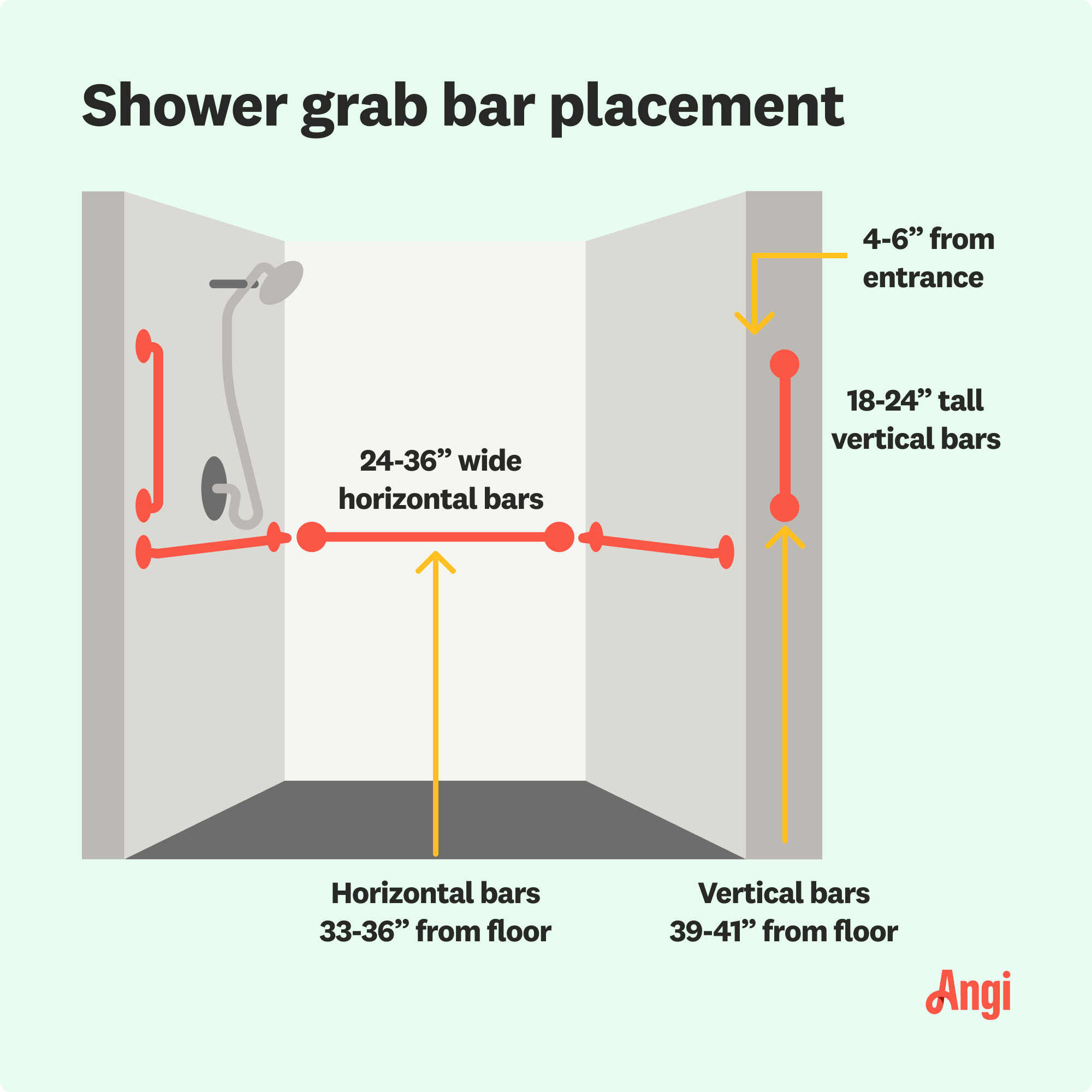How to Install Shower Grab Bars for an Accessible Bathroom
Create the safe showering space you need at home with these steps


- Leveler
- Caulk gun
- Drill
- Wood drill bits
- Glass-and-tile drill bits
- Dish soap
- Water
- Grab bar
- Anchors
- Caulk
When you need to create a safer showering experience for you or your loved ones, most homeowners consider installing grab bars. They’re a great way to make showers more accessible while maintaining an aesthetically-pleasing bathroom. This guide will help you learn how to install shower grab bars and when to hire a pro.

Gather Supplies and Measure
 Photo: Aiman Dairabaeva / iStock / Getty Images
Photo: Aiman Dairabaeva / iStock / Getty ImagesOnce you’ve gathered all your tools and supplies, you’ll need to clean your bathroom to allow for caulk to stick. Caulk needs a dirt-, dust-, and oil-free surface to adhere to for maximum performance. Dish soap and warm water should cut through those layers of dirt and grime. Give your shower a few hours to completely dry before starting your project.
You’ll want to make sure that your shower has the necessary space to install grab bars.
Where Should Grab Bars Be Placed in a Shower?
According to the Americans with Disabilities Act (ADA), the width of the gripping distance should be 1 ¼ to 1 ½ inches wide, and the space between the wall and the grab bar should be 1 1/2 inches. You should also ensure that any walls next to your grab bar are free of sharp or abrasive edges. The edges’ minimum radius should be 1/8 of an inch.
The size of the grab bars and the placement depend on the wall of the shower:
Entry Wall: Place a 18- or 24-inch grab bar vertically and about 4–6 inches inward from the door jamb or shower entrance. Aim for about 39–41 inches from the floor.
Side Wall: Place a 24- or 36-inch grab bar horizontally and at waist height. Aim for 33–36 inches from the floor. You can install a 48-inch grab bar diagonally at a 45-degree angle for those showering in a seated position.
Front Wall (Plumbing Wall): Place a 24- or 36-inch grab bar vertically so it sits at waist height and about 39–41 inches from the floor. Alternatively, install the bar vertically where you can reach it while sitting or standing.
Determine the Position of the Grab Bars
After double-checking that your spacing meets the ADA’s requirements, you need to decide where to place it. The general rule of thumb is to install your grab bar around waist level. You’ll need to get in your shower and see where that is for you and your family.
Use a Stud Finder
Once you have a general sense of where you want to install your grab bar, you need to find the studs in that area. Use a stud finder and mark off your stud's left and right edges with painter’s tape and repeat this process for both ends of your grab bar. Then use a pencil to mark its center lightly. It’s important that you know where your stud is and its distance so you can avoid drilling into any electrical wires or plumbing lines.
If you have tile walls or walls thicker than drywall, it’s harder for a dielectric constant (DC) stud finder to pick up your stud’s location. One option is to use a deep scan stud finder, slowly move it horizontally, and mark everywhere with a positive reading. In an area that has multiple marks, that’s likely where your stud is located.
Another option is to go into the room that shares a wall with your shower and find the studs there. Then measure the distance of where those studs are and take those measurements to see where your shower studs should be.
Mark the Placement of the Screws
Once you’ve found your studs, place your grab bar where you want it to go, then use a pencil to mark your screw placement. Use a leveler to make sure your bar is, well, level.
Predrill the Pilot Holes
Now, use your drill to make pilot holes. If you're installing your grab bar on drywall, use a drill bit slightly smaller than your mounting screw. If drilling through tile, use a glass-and-tile bit roughly half the size of your mounting bit and drill until you’ve reached the end of your tile. Then drill one-eighth of an inch hole into the stud using a wood bit. Check your manufacturer’s guide for specific instructions; they’ll tell you the exact size and type of bits you need.
Use Wall Anchors, if the Wall Is Tiled
If you can’t find the studs on your tiled wall, you’ll need to use appropriate-sized wall anchors to secure your grab bars, following the instructions provided.
Install and Secure the Grab Bars
Now you’ll need to position your grab bar back on the wall, over your pre-drilled holes, then fasten the screws that came with it into the wall.
Spread Caulk Around the Seam
After your grab bar is in place, put your caulk inside your caulk gun and apply it around the seams to prevent water from getting into your walls through your drilled holes. Then slide the metal cover plates back onto their respective ends once you’re finished caulking.
Test the Grab Bars
Pull on your grab bar once the caulk has dried to ensure it’s secure and safe.
DIY Grab Bar Installation vs. Hiring a Pro
Shower grab bar installation is a fairly simple DIY that most homeowners could tackle, especially if you have experience finding studs.
However, shower grab bars are designed to help prevent shower falls; improper installation can be a major safety hazard. Plus, if you're not careful, you can accidentally crack your tiles. If you only need a grab bar installed, hire a handyperson or local shower installer to take care of the project the same day.
How Much Does It Cost to Install Shower Grab Bars?
A handyperson costs $50 to $150 per hour on average. If you’re confident you can safely DIY the project, you’ll need a few additional tools and supplies, which should cost you less than $100 for the entire project.
Install shower grab bars around the waist level or wherever it’s most comfortable to grab inside the shower. If multiple people will be using the grab bar, install it in a location that works best for everyone. You’ll also want to install a vertical grab bar close to your shower’s entrance to help you get in and out.
It depends on your or your loved one’s needs. One grab bar will do if you only need help getting in and out of the shower. You might need two: one near your shower’s entrance if you need help getting in and out of your shower and another to help you move around inside it.
Grab bars installed diagonally provide additional support and stability and are more accessible for some people to grab. If more than one person needs to use it, installing them at an angle lets it easily accommodate different heights. They’re also a good option for showers without space for a horizontal grab bar.
For maximum stability, install grab bars on wall studs, as this will adequately support the weight. However, if you don't have access to studs, you can get by with wall anchors. If opting for the latter, choose specialty hollow wall anchors.





- Bathroom Remodeling
- Kitchen Remodeling
- Shower Installation
- Stair Installers
- Bathtub Installation
- Shower Door Installers
- Kitchen Design
- Bathroom Design Companies
- Storm Shelter Builders
- Pre-Made Cabinets
- Kitchen Refacing
- Bathtub Replacement
- Ceiling Tile Installation
- Suspended Ceiling Companies
- Residential Designers
- Stair Builders
- Remodel Designers
- Shower Enclosures
- Home Renovations
- Kitchen Renovations
- Garage Remodeling
- Grab Bar Installation
- Walk-In Tub Installers
- Tub to Shower Conversion
- Balcony Contractors









